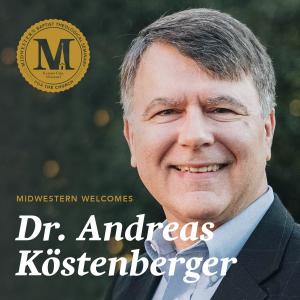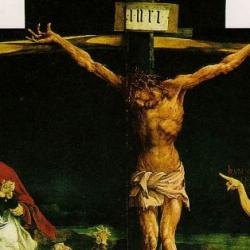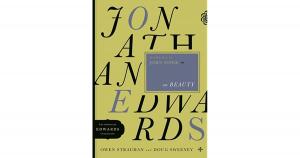 Yesterday at Kenwood Baptist Church in Louisville, Kentucky, Jim Hamilton preached a sermon on John 8:12-30. It was typical of Jim’s sermons: loaded to the brim with exegetical and biblical-theological insight, passionately delivered, and punctuated by a summons to faith in Jesus, the light of the world. I love serving with Jim, Denny Burk, and a band of brothers as an elder at KBC.
Yesterday at Kenwood Baptist Church in Louisville, Kentucky, Jim Hamilton preached a sermon on John 8:12-30. It was typical of Jim’s sermons: loaded to the brim with exegetical and biblical-theological insight, passionately delivered, and punctuated by a summons to faith in Jesus, the light of the world. I love serving with Jim, Denny Burk, and a band of brothers as an elder at KBC.
Here, though, is what was not typical about this sermon: Jim spent about ten minutes detailing not what he was teaching about, but what he was not teaching about. He was exactly right to do so, because he was handling John 7:53-8:11, a text that is in brackets in the ESV and other translations. Jim made clear that he would not preach about the text because it is not part of John’s gospel. He listed several reasons why he has come to this conclusion. (You can listen to the audio or read Jim’s remarks over at his blog, which I’m quoting from.) Here’s one–the manuscript evidence:
John 7:53–8:11
is not in any of the best texts: P66, P75, Codex Sinaiticus, Codex Vaticanus, etc. As the note above the passage in the ESV states, the earliest manuscripts do not include it. As the footnote in the ESV text states, some manuscripts contain this passage, but not following John 7:52
. Some have it after John 7:36
or 21:25
or even Luke 21:38
. Again, the fact that we have enough manuscript evidence to arrive at this conclusion shows that we can be practically certain about the original contents of the text of the New Testament.
Here’s another–the language of the passage in question:
Have you noticed that John always refers to the opponents of Jesus as “the Jews”? Did you notice that John never refers to the scribes? The only instance of the word “scribes” in John’s Gospel is in the interpolated passage at 8:3. In fact there are 14 words in John 7:53–8:11
passage that occur nowhere else in John’s Gospel.
Read the whole piece. I encourage you to carefully consider Jim’s argument. He approaches this both as a pastor and as a world-class New Testament theologian (his books definitely belong on your shelf, including God’s Glory in Salvation through Judgment and What Is Biblical Theology?). In sum, I believe the case as Jim lays it out is persuasive. It accords with the judgment of numerous other scholars and it lines up with how the ESV and other translations treat the text.
Here, for example, is John Piper’s list of a number of scholars who concur with this evaluative judgment:
- Don Carson, who teaches at Trinity, and is in my view one of the best New Testament scholars in the world, writes, “Despite the best efforts . . . to prove that this narrative was originally part of John’s Gospel, the evidence is against [them], and modern English versions are right to rule it off from the rest of the text (NIV) or to relegate it to a footnote (RSV).” (The Gospel According to John, 1991, p. 333)
- Bruce Metzger, one of the world’s great authorities on the text of the New Testament until his death in 2002: “The evidence for the non-Johannine origin of the periscope of the adulteress is overwhelming.” (The Textual Commentary on the Greek New Testament, 1971, p. 219)
- Leon Morris: “The textual evidence makes it impossible to hold that this section is an authentic part of the Gospel.” (The Gospel According to John, 1971, p. 882)
- Andreas Köstenberger: “This represents overwhelming evidence that the section is non-Johannine.” (John, 2004, p. 246)
- And Herman Ridderbos: The evidences “point to an unstable tradition that was not originally part of an ecclesiastically accepted text.” (The Gospel of John, 1997, p. 286)
Taking all of the above into account, I have two thoughts on the matter as a church elder and a theologian.
First, I think it is confusing for many lay Christians to have John 7:53-8:11 in brackets in their Bible (the same is true of Mark 16:9-20, but I’m not tackling that text here). It’s not super-confusing for a seminary graduate when you encounter this passage, because many of us encountered it in our exegetical training (one major reason why heavy exegetical investment at the MDiv level is so helpful–you have a textual fund for later). I took five Greek and five Hebrew classes in my work at SBTS and covered John 7:53-8:11 twice–first in Greek Exegesis with Mark Seifrid and later in a terrific elective on John with Andreas Köstenberger.
I fully understand why translation committees have put the passage in question in brackets. They’ve done a careful job of handling a tough issue. I respect their work and have no quarrel with it. I do see one problem with this decision, though: most people reading their Bibles don’t know what to do with a text in brackets. They read the comment that most early manuscripts don’t include this passage in John’s Gospel and they come away confused. What does that mean, exactly? If it’s not in the earliest versions of John’s writing, why is it in their translation? And what do the brackets signify, exactly? Are you supposed to read it? Not supposed to read it?
Is it actually sinful to read it? Yikes.
My second thought, then, is this: I think as Hamilton (and fellow elder and New Testament theologian Denny Burk, alongside a host of witnesses) does: modern translations would serve the church very well by moving John 7:53-8:11 to a footnote or some such holding place. If scholars speak with a nearly univocal voice that this passage is not part of John’s Gospel, then let’s go one further than our translations already have (thankfully!), and consider moving it out of brackets and into a footnote. Our goal here is maximum clarity and minimum confusion.
I am grateful to our modern translators. Their work is often thankless and even anonymous–except, that is, when people disagree with their judgments! In this case, I fully understand the reasoning of past days. I respect it. But I wonder if it might serve the church better by moving this passage out of the flow of John’s Gospel. This is especially true for younger Christians and those who do not have advanced training in biblical studies. I’m confident that we could solve some confusion by doing so.
I offer this thought because of the weight of exegesis and scholarly consensus that exists on this matter. With Jim, I encourage this change not because of hot-headedness. I support this move because I don’t think the passage in question belongs in John’s Gospel. Removing it would lend serious clarity to our engagement with John’s flow of thought. I’m thankful Jim raised this matter at Kenwood, and I hope that others will judiciously consider the arguments and move for the same action.











